By Lorie Eber, Certified Nutritionist
Tiger Nuts may be the next trendy superfood and for good reason; they’re packed with prebiotic fiber and antioxidants and are also gluten-free. According to VOGUE MAGAZINE this nutrient-rich little gem is “edging out almonds and cashews as granola’s dynamic new best friend.

Despite their name, Tiger Nuts aren’t actually nuts and have nothing to do with the animal kingdom. If you’re never seen a tiger nut, it looks a little like a dried garbanzo bean (chickpea). Tiger nuts are actually tubers or root vegetables that grow under Cyperus esculentus grass, a type of ground cover. The “tiger” nomenclature is a recognition of the faint stripes on their skin. Tiger nuts have a very long history. An Oxford University study concluded that 2.4 million years ago our East African ancestors survived mainly on a diet of tiger nuts. Horchata, a vegetable milk made from tiger nuts, has been popular in Spain since the 13th century.
1. Tiger nuts are prebiotics. Prebiotic foods like tiger nuts contain indigestible fiber and sugars that stimulate and nourish the good bacteria in our intestines. Good gut bacteria is associated with a wide range of health benefits, including obesity prevention, diabetes control and gastrointestinal health
2. Tiger nuts are allergen free. Tiger nuts are safe for those with nut allergies. They’re free of soy, grain, nuts and seeds.
3. Tiger nuts are a rich source of dietary fiber. A one-ounce serving of tiger nuts satisfies about 40% of our daily fiber needs. This tiny root vegetable packs 10 grams of fiber into a single ounce. A diet high in fiber can help reduce risk factors for heart disease and keep blood sugar levels consistent.
4. Tiger nuts make a tasty gluten-free flour.
A study looking into the health benefits of tiger nut flour discovered that it has a higher fiber content than rice bran, oats and apples. Tiger nut flour can be substituted partially in recipes for baked goods that call for all-purpose flour. It’s also gluten, nut and allergen free.
5. Tiger nuts are a good source of healthful fats. One ounce of tiger nuts (30 grams) contains about 120 calories and 7 grams of fat, with the fat composition being about 73% monounsaturated fat, 18% saturated fat and 9% polyunsaturated fat. Eaten in moderation, monounsaturated fats can have a positive impact on your health. Monounsaturated fat is a key feature of the Mediterranean Diet, a healthy eating plan that’s linked to increased longevity and reduced chronic pain.
6. Tiger nuts are a good source of iron. A one-ounce serving of tiger nuts contains 1.8 milligrams iron, or about 10% of the recommended daily intake of iron for adults.
7. Tiger nuts are a rich source of antioxidants. Diets rich in antioxidants, such as vitamin E and oleic acid, protect the body from damage caused by free radicals which can lead to disease. A past study analyzing the benefits of tiger nut oil concluded that its scavenging capacity helped destroy disease-causing molecules.
8. Tiger nuts lower bad cholesterol. Research involving the tiger nut beverage known as horchata showed that its high-fiber content helped absorb LDL (bad) cholesterol from the blood.
How to Enjoy Tiger Nuts
Tiger Nuts are quite versatile. They have a nutty flavor, reminiscent of almonds. Think of them as an alternative to nuts. They can be enjoyed in breakfast smoothies, salads or as a yogurt topping. Whole tiger nuts make a great snack when peeled and softened by roasting. The oil can be used instead of olive oil.
We do hope that you enjoyed this article by Lorie Eber, and if you have any questions about Tiger Nuts, just drop us an email at nuts@tigernutsusa.com
By the way if you are a health food, or just a healthy blogger, please drop us a line at nuts@tigernutsusa.com so that we can open a dialogue and see if we have a good fit, and we can get you some Tiger Nuts to taste test and review.










